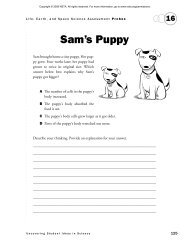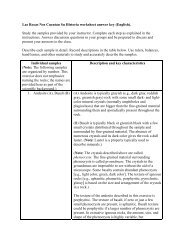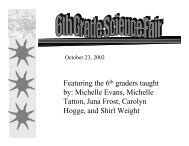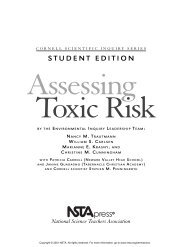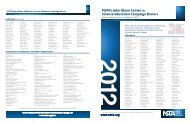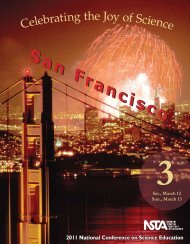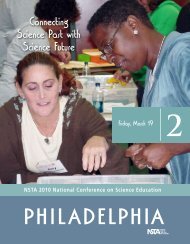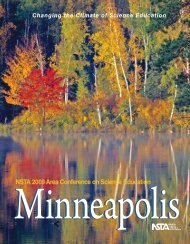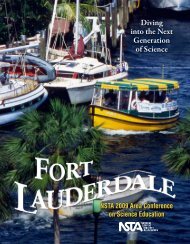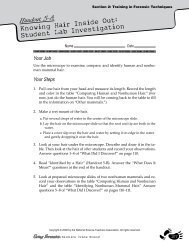New Orleans Program, Vol. 1 - National Science Teachers Association
New Orleans Program, Vol. 1 - National Science Teachers Association
New Orleans Program, Vol. 1 - National Science Teachers Association
Create successful ePaper yourself
Turn your PDF publications into a flip-book with our unique Google optimized e-Paper software.
Thursday, 12:30–1:30 PM<br />
196<br />
Soar Through the Solar System —<strong>Science</strong> Education <strong>Program</strong>— (Earth)<br />
(Elementary) Room 343, Convention Center<br />
Julie E. Taylor (julie_taylor@eee.org), Solar System Educator, Victorville, Calif.<br />
In this fast-paced hands-on workshop you’ll learn how to scale the solar system in correct<br />
size, distance, and volume using materials found in the kitchen.<br />
Uncovering Student Ideas with Everyday <strong>Science</strong> Mysteries —<strong>Science</strong> Content—<br />
(Gen)<br />
(Elementary–Middle Level) Room 344, Convention Center<br />
Joyce Tugel, Maine Mathematics and <strong>Science</strong> Alliance, Augusta<br />
Richard Konicek (konmor@comcast.net), University of Massachusetts, Amherst<br />
Presider: Page Keeley (pkeeley@mmsa.org), NSTA President, and Maine Mathematics and<br />
<strong>Science</strong> Alliance, Augusta<br />
<strong>Science</strong> stories can engage all students, elicit ideas encountered in the K–8 curriculum, and<br />
provide an entry into inquiry.<br />
NMLSTA Session: CupCave: How an Egg in Vinegar Became the Anchor for a<br />
Unit on Caves —<strong>Science</strong> Teaching— (Earth)<br />
(Middle Level) Room 353, Convention Center<br />
Holly L. Yoder (hyoder@elkhart.k12.in.us), Pierre Moran Middle School, Elkhart, Ind.<br />
Discover how the simple “egg in vinegar” lab became the basis for a cave formation unit.<br />
Build a cave and word wall and incorporate literature, too.<br />
Gadgets and Gizmos in the Kitchen: Technology in Everyday <strong>Science</strong> —<strong>Science</strong><br />
Teaching— (Phys)<br />
(Elementary–Middle Level) Room 354, Convention Center<br />
Richard A. Frazier (frazier@ucmo.edu), University of Central Missouri, Warrensburg<br />
Gadgets and gizmos help students explore and appreciate big ideas in science in the comfort<br />
of the kitchen. <strong>Science</strong> in the kitchen makes science real.<br />
How Do We Know? Using the Electromagnetic Spectrum to Map the Universe<br />
—<strong>Science</strong> Content— (Earth)<br />
(Preschool–Middle Level) Room 356, Convention Center<br />
Linda L. Smith (lsmith@paulsboro.k12.nj.us), Loudenslager Elementary School, Paulsboro,<br />
N.J.<br />
Create a scale model of the universe, catch a light ray in a tube, detect EMS radiation using<br />
everyday materials, and then take home a NASA CD and handouts.<br />
Physics Is Elementary —<strong>Science</strong> Content— (Phys)<br />
(Elementary) Room R03, Convention Center<br />
Nathan Heiselt (nericheiselt@bagley.msstate.edu), H. Teresa Carter (reccarter@hotmail.<br />
com), and Sonya Smith (sc54msu@hotmail.com), Mississippi State University, Mississippi<br />
State, Miss.<br />
Amy Cummins (amyscummins@hotmail.com), Lee Middle School, Columbus, Miss.<br />
Gloria Seward (gseward99@yahoo.com or gseward@neshoba.k12.ms.us), Neshoba Central<br />
Elementary School, Philadelphia, Miss.<br />
Come get hands-on inquiry activities for teaching physics in the elementary school in this<br />
share-a-thon!



